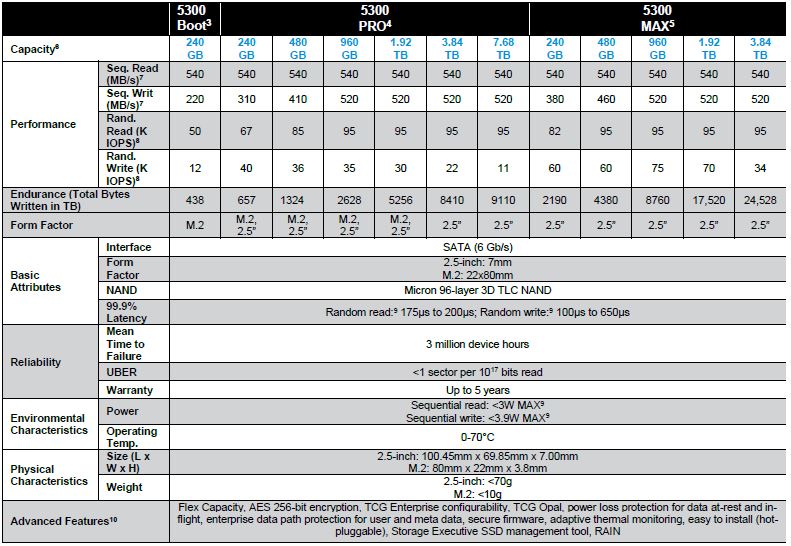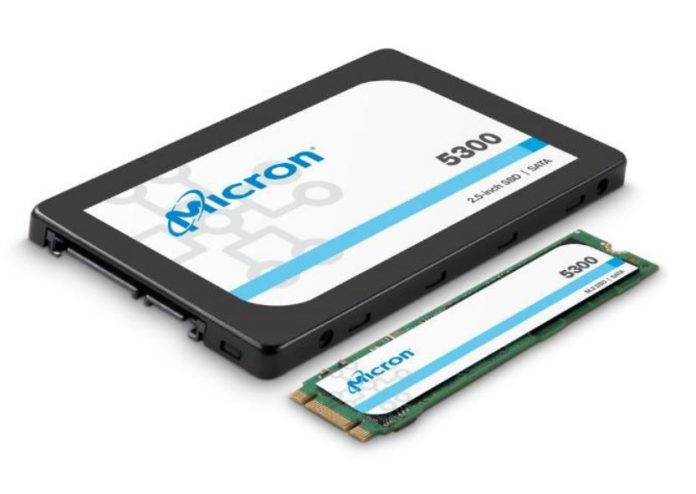In 2019 we are finally seeing the transition from SATA to NVMe SSDs. Still, SATA has a large installed base. Micron is targeting its newest SSDs to a large number of SATA ports on current-generation platforms. The company is even releasing a formal “Boot” option that we really like.
Micron 5300 Series
The Micron 5300 series comes in three flavors, Boot, PRO, and MAX. Each is targeting a unique segment.
Micron 5300 Boot
The capacity for the Micron 5300 Boot variant is 240GB. It is designed to have solid performance as a boot device but it is not targeted as the highest-performance segments with 540MB/s read and 220MB/s write speeds. Given the number of machines that boot off of SD cards or SATA DOMs, this is a great concept. Even looking at the Inspur NF5180M5 we reviewed this week, there are two 80mm M.2 SATA boot headers for drives exactly like the Micron 5300 Boot.
Micron 5300 Pro
The Micron 5300 Pro ranges in capacities from 240GB to 7.68TB. We think these may be the most popular drives. They can replace traditional hard drives trading cost for performance and reliability.
These drives, even from the 480GB model have over 1PBW of write endurance which is plenty for drives of this class. Performance is the same 540MB/s sequential reads as the rest of the series, but write speeds vary for the 240GB and 480GB models from the 520MB/s for the rest of the line.
Here Micron uses both the M.2 and 2.5″ form factors. With the 3.84TB and 7.68TB models only coming in 2.5″ flavors. Micron is using the “PRO” label to denote 1 DWPD SSDs.
Micron 5300 MAX
With the “MAX” label, the Micron 5300 MAX is designed to be a 3 DWPD higher-performance model line. Capacities for this series range from 240GB to 3.84TB. Sequential speeds are somewhat comparable to the PRO line, but the 4K random write IOPS are much higher generally 2-7x higher than the 5300 PRO series.
The MAX line only comes in 2.5″ form factors, not M.2. Like the other drives, the MAX is still using 3D TLC NAND. This is also the series that is under siege by the NVMe drives that offer a higher performance interface to go along with a higher performance drive.
Micron 5300 Key Specs
Here are the key specs for the Micron 5300 series:






I can’t find the 5300 PRO anywhere. Does anyone know where to purchase them in the EU and how much the 4TB and the 7.7 TB models cost?
Thanks
Got one 450GB just for testing. Very cheap drive with battery-backed cache (it seems).
Nothing special so far in performance, but I awaits to do a MS-SQL benchmark some day when I get time. Hopefully the battery-backed cache will improve performance when doing sync IO (as MS-SQL do), that’s why I got one to test it out.
But one thing is sure Micron is a mess!
I sent them a mail about the cmd line tool msecli for linux didn’t work AT ALL. The binary on their homepage was simply corrupted. Newer heard back from them!. But about a month later I found out the finally updated the file on the website.
I also sent them a mail asking about the cache size, which is a pretty important parameter in regards to the sync IO performance. Again never heard anything. Nothing about it nowhere.
And the info cannot be retrieved from the msecli, which I’m in general is not impressed by.
All in all the msecli is a mess too. Errors in the –help information and wrong information in the readme file.
Well, maybe it’s wrong to call it “battery”, I assume it’s a capacitor, but you know what I mean ;-)
I finally got time to do a benchmark on bare metal MS-SQL.
It doesn’t perform any better than the Crucial MX500 consumer SSD!
I don’t think it’s a coincident that it’s now specified ANYWHERE the size of the cache. Beside endurance it is the most important feature of this drive and the only reason to buy it (well, if it was larger than 1KB). It’s cheap and now we know why!
Micron might have greate enterprise drives, but this is NOT one of them.